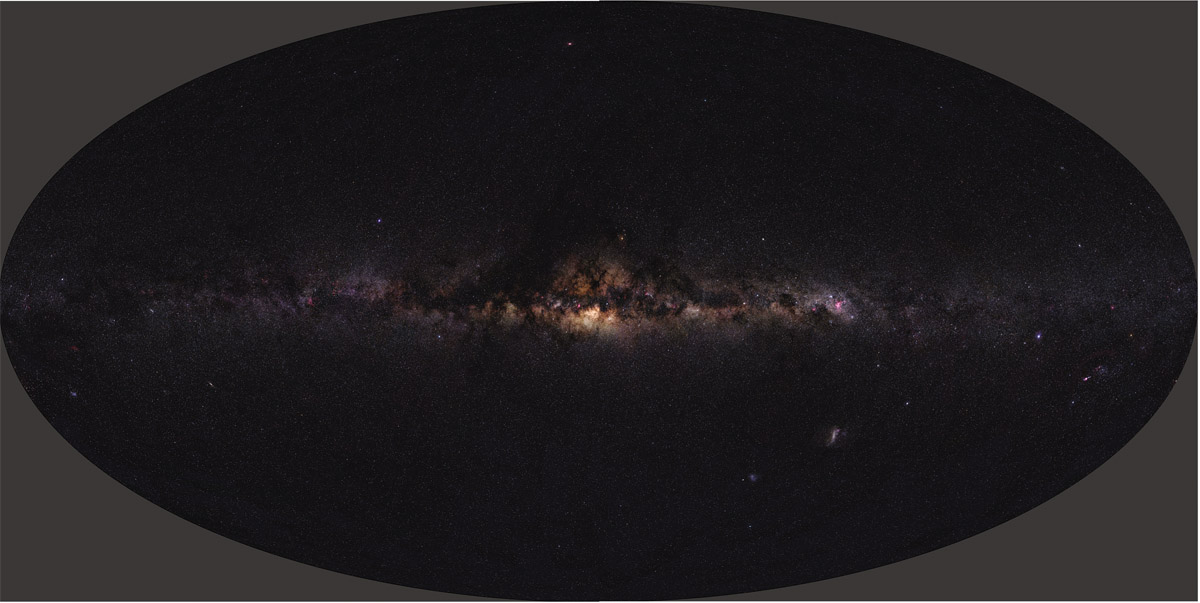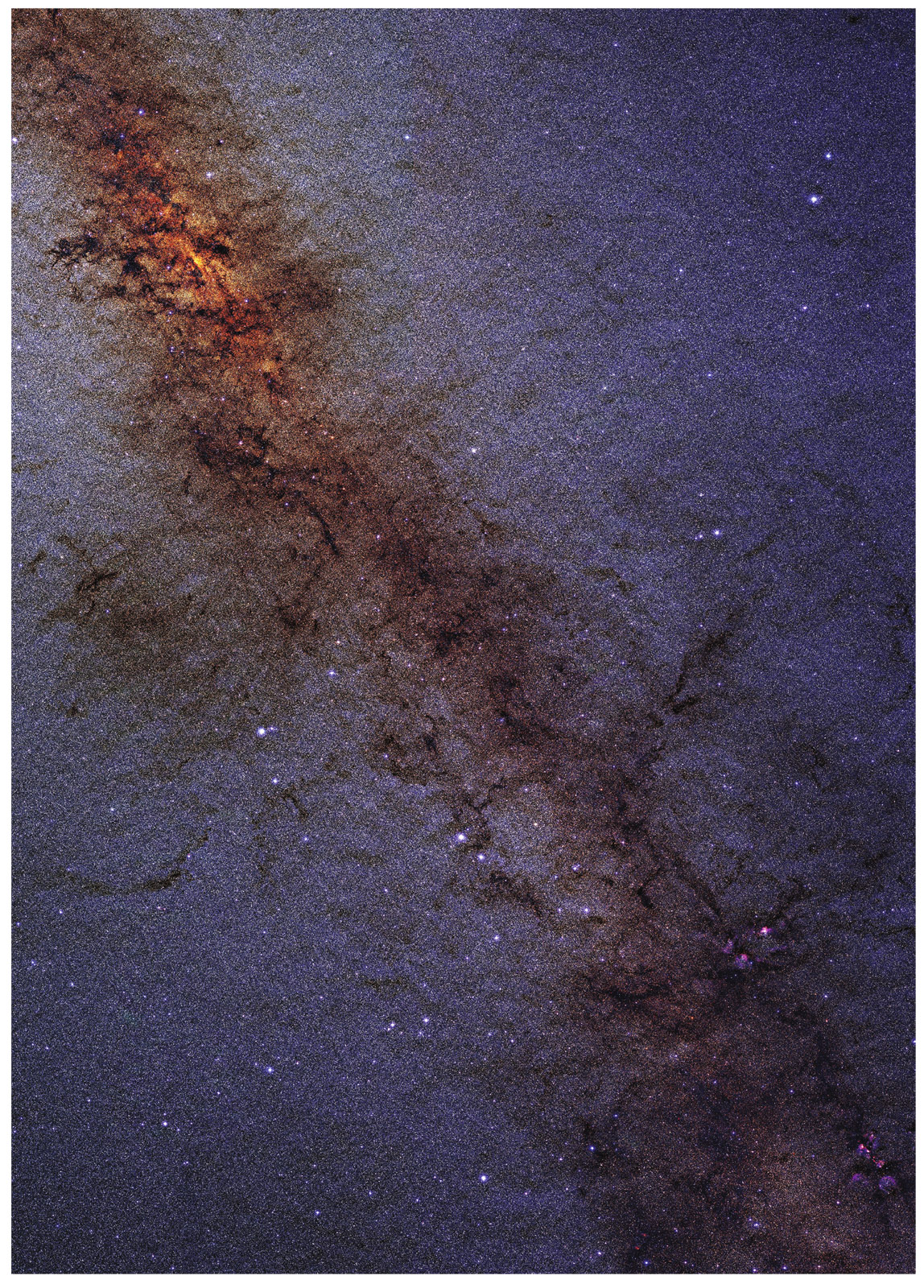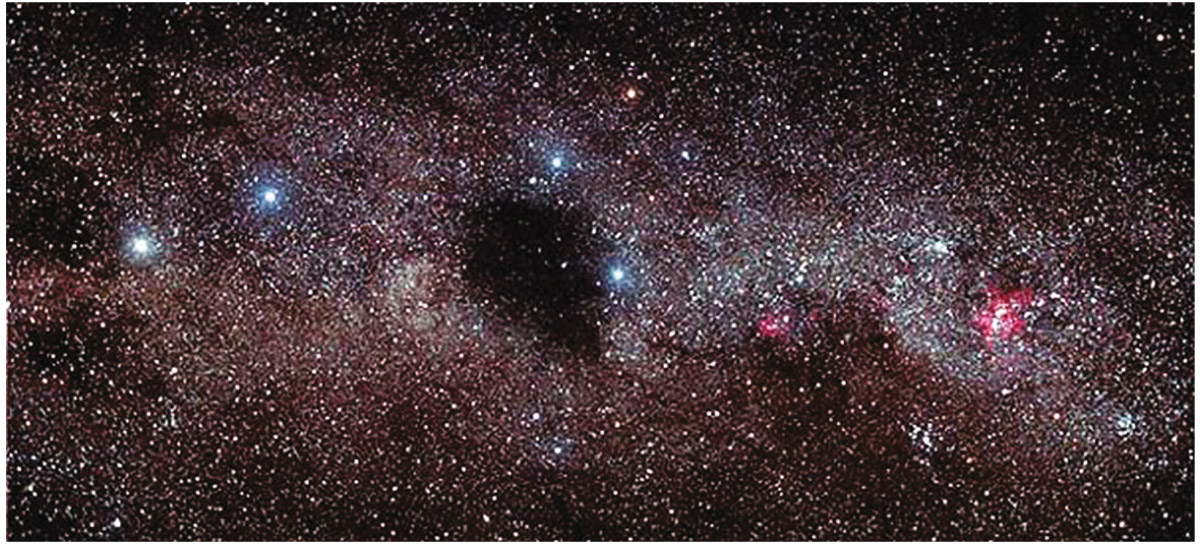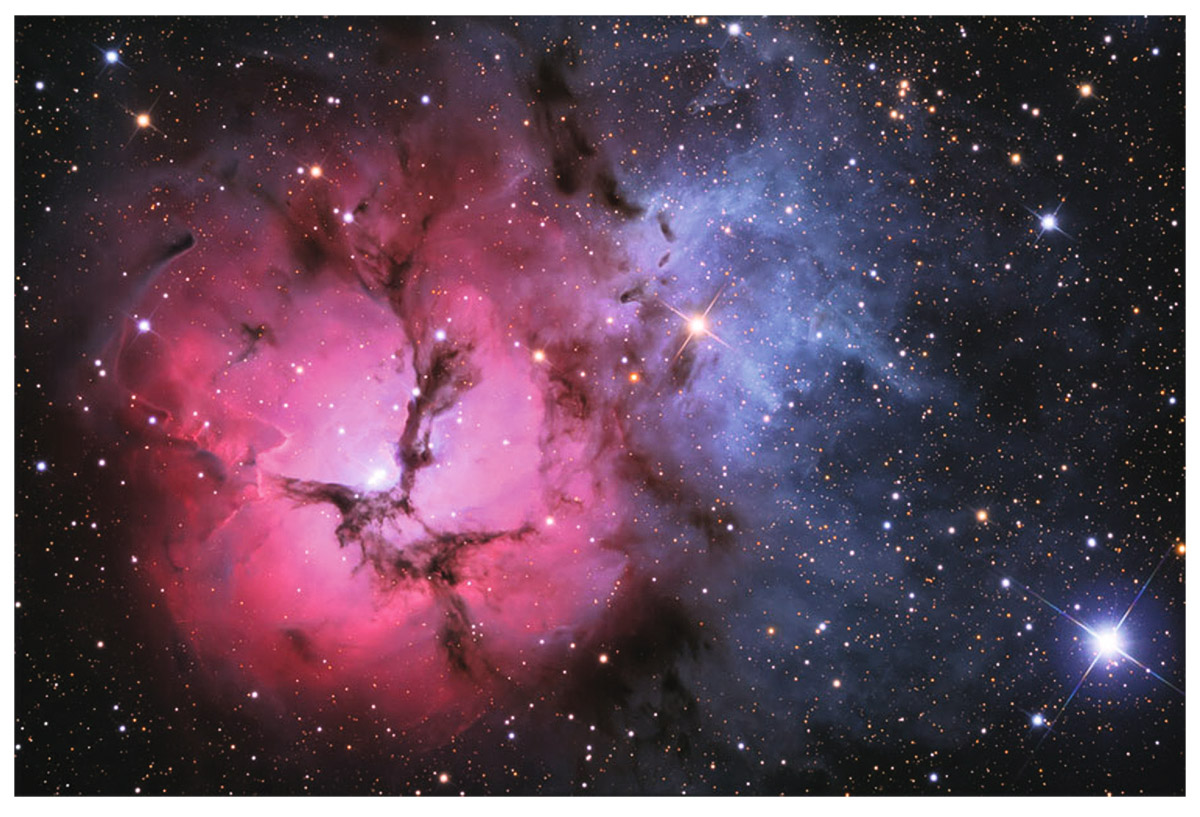11
THE INTERSTELLAR MEDIUM
MICHAEL A. STRAUSS
We now move from the study of individual stars and planets to a broader view of how stars fit into our own Milky Way galaxy and the interaction between stars and what we call the interstellar medium. So far we have talked about the space between the stars as if it were essentially empty, but I want to convince you in this chapter that the huge volume of space between the stars actually contains a large amount of material—it’s just thinly spread out. Interstellar, of course, means between the stars, while medium means “stuff.” So the interstellar medium is the “stuff between the stars.”
Let’s take a look at the interstellar medium, which has produced many of the most beautiful images in astronomy.
Figure 11.1 is a composite picture compiled from a variety of images of the Milky Way. It illustrates the full sphere of the sky, projected in a clever way onto a flat plane. The band of light called the Milky Way that we sometimes see arching across the night sky actually stretches in a full circle all the way around the celestial sphere, tracing out what we call the galactic equator. Our Milky Way galaxy is a disk of stars, and because we are located in this disk, when we look out into it, we see a band of light circling the sky. The brightest part of the Milky Way (toward the galactic center, in the center of this picture) is not clearly visible from mid-latitudes in the Northern Hemisphere. If you ever get to the Southern Hemisphere, on a clear moonless night away from city lights, look up! Especially from March through July, the southern view of the Milky Way is tremendously dramatic, much brighter than what those of us who live in the North can see.
Since we are halfway out from the center in the disk, the picture gives the appearance that we are looking at the Milky Way edge-on from outside. One of the things you will notice right away is that the Milky Way is not smooth, but seems to have black blotches or patches in it. If you look at it with a telescope, you’ll see (as Galileo famously did) that the diffuse light of the Milky Way actually is due to combined light of myriad stars, but there are regions (dark lanes) in which no stars are apparent. One hundred years ago, astronomers argued about what could account for these lanes. One possibility they considered was that the distribution of stars is intrinsically patchy, and the dark regions are simply those places in which there happen to be very few stars. Alternatively (and this is the right idea), there is a smooth distribution of stars, but something is blocking our view of them. That something is indeed the interstellar medium.

FIGURE 11.1. Panorama of whole sky showing the Milky Way. Distant stars in the Milky Way form a band of light that circles the sky along the galactic equator, mapped as a straight horizontal line across the center of the map. The Milky Way galaxy’s center is in the center of this figure. Note the dark lanes and patches along the Milky Way where background stars are obscured by dust. Photo credit: Adapted from J. Richard Gott, Robert J. Vanderbei (Sizing Up the Universe, National Geographic, 2011) Based on data from Main Sequence Software.
One way the interstellar medium manifests itself is by being quite opaque. It is thin stuff, but the volume of space it occupies is large. In Earth’s atmosphere, even a very thin haze or a small amount of smoke can obscure distant objects. The interstellar medium has tiny dust particles just like those in smoke. Indeed, “dust” is the technical term astronomers use to refer to these particles, but perhaps “smoke” would be a better word. This material is highly rarified, but over enormous distances, its effects mount up and can absorb the light of background stars. In some directions, the cumulative effect of the dust is so pronounced as to completely obscure the light of background stars. Because of dust, for example, the very center of the Milky Way is completely obscured to visible light.
It turns out that the dust obscures light of short wavelengths more than it does long wavelengths. At longer infrared wavelengths, the dust causes far less absorption than it does in visible light, and one can get a largely unobscured view of the Milky Way. Figure 11.2 is a close-up picture of the center of our Galaxy taken with the Two Micron All-Sky Survey (or 2MASS, an appropriate acronym, since this survey was led by astronomers at U Mass, the University of Massachusetts). As the name implies, the 2MASS uses infrared wavelengths of about 2 microns (2 × 10–6 meters), considerably longer than visible light (0.4–0.7 microns). You can see that the light in the picture is coming from individual stars. The effects of dust are still apparent but are not nearly as extreme as in visible light. Preferentially suppressing blue light from an object makes it appear red. Therefore, when we see stars through dust they appear “reddened” relative to their normal color. The brightest small red clump peeking out from behind the dust at the upper left is the galactic center itself, a tight group of stars which harbors a 4-million-solar-mass black hole.

FIGURE 11.2. The Milky Way center. The dust of the Milky Way obscures short-wavelength light more than longer wavelengths, giving the stars behind that dust a distinctly reddish tinge. There are about 10 million stars in this image, which measures about 4,000 light-years across. The exact center of the Milky Way is the densest red spot in the upper left. Photo credit: Atlas image obtained as part of the Two Micron All Sky Survey, a joint project of the University of Massachusetts and the Infrared Processing and Analysis Center/California Institute of Technology, funded by NASA and the NSF
Figure 11.3 shows a dark region called the Coalsack Nebula, a big dust cloud that completely obscures the stars behind it, leaving a blank spot in the sky that is quite apparent to the naked eye. Australian Aboriginal astronomers have known of the Coalsack Nebula for almost 40,000 years. It forms the head of the Emu, a dark pattern in the Milky Way famous in Aboriginal lore.
Thus, the interstellar medium is far from smooth, containing many clumps or clouds that are particularly dense. In addition to dust, it contains gas composed of hydrogen, oxygen, and other elements. We refer to the various fuzzy, or cloudlike, objects we see in the sky (as opposed to the pointlike stars) as nebulae, from the Middle English nebule for cloud or mist, which in turn comes from the Latin nebula for mist or fog. These gas clouds do more than just obscure our view of the stars. Figure 11.4 shows the Orion Nebula, which can be seen with the naked eye. It is at the bottom of Orion’s sword hanging down from his belt. Even through binoculars, it appears markedly fuzzy, not sharp like a star. Ultraviolet light from hot stars can excite the gas in the interstellar medium. The photons from the hot luminous young stars in the nebula excite atoms in the gas to high energy levels. As the electrons drop back to lower levels, the atoms emit photons at specific wavelengths, as we saw in chapter 4, giving rise to the colorful nebulosity we see. This fluorescence is the same process that happens inside a neon bulb, and in fact, neon is one of the elements present in the interstellar medium.

FIGURE 11.3. The Coalsack Nebula. This is a region of the Milky Way completely obscured by a dense foreground cloud of dust. Photo credit: Vic Winter and Jen Winter

FIGURE 11.4. Orion Nebula. The bright colors in this star-forming region are caused by fluorescing gas illuminated by the young bright embedded stars. Filaments of dust are also visible. Photo credit: NASA, ESA, T. Megeath (University of Toronto), and M. Robberto (STScI)
The Orion Nebula is an example of an emission nebula, which is to say that its spectrum is dominated by emission lines corresponding to various electronic transitions in the atoms. We can identify the specific elements in the nebula by the wavelengths of their emission lines. The reddish color in the image is due to emission of photons when electrons drop from the n = 3 to the n = 2 energy level in hydrogen (Hα, one of the Balmer lines, described in chapter 6). The hint of green color is due to oxygen, and other elements produce the remaining light. The dark regions are caused by patchy dust, mixed in with the gas.

FIGURE 11.5. Trifid Nebula. The red light is fluorescing gas shining in hydrogen alpha (Hα) emission , while the blue light is mostly starlight reflected from the abundant dust. Photo credit: Adam Block, Mt. Lemmon SkyCenter, University of Arizona
The object in figure 11.5 is called the Trifid Nebula, because it is divided by lanes of dust into three parts. These dust lanes hide the emission that would otherwise make the nebula appear smooth. As before, embedded hot stars are causing the gas to glow, and the red emission is due to Hα. The extended blue emission to the right is light from blue stars reflected off the dust, which acts as a sort of mirror. We call this part a reflection nebula. Remember that blue light going through dust is absorbed, which is why stars seen through a dust cloud appear reddish. That blue light has to go somewhere; it tends to be either absorbed or reflected in a different direction. So reflection nebulae tend to be blue.
The Pleiades is a young cluster of stars which is easily visible to the naked eye. Pictures taken with a large telescope (see figure 7.2) show that its stars are illuminating dust, resulting in a blue reflection nebula. Each blue star is surrounded by a blue fuzzy patch.
The interstellar medium is the raw material from which stars are made, as we touched on in chapter 8. The interstellar medium is quite diffuse over most of the Milky Way galaxy, but in certain regions, such as in emission nebulae and dark clouds, it is relatively dense—these are the regions that are ripe for star formation. Gravity pulls a small knot in the cloud of dust and gas together. As it collapses, it heats up, converting its gravitational potential energy to kinetic energy as it falls inward, eventually becoming hot and dense enough for thermonuclear reactions to take place, and a star is born. The core of the Trifid Nebula is filled with massive hot blue stars. These stars live fast and die young. So these stars must have been born recently.
The scale in which this is happening is enormous. In the Orion Nebula, we have observed about 700 stars in the process of forming, many of which have disks of gas and dust surrounding them that may eventually form into planets. As in the Orion and Trifid Nebulae, stars tend to form in large groups rather than in isolation. With time, the radiation and stellar winds from the young stars evaporate and blow away the dust surrounding them, gradually unveiling the stars. Young stars also often emit winds, consisting of hot gases emitted from their surface, analogous to—but stronger than—the solar wind that our own Sun emits. These winds sculpt the gas and dust around them, which can give some nebulae a windswept look.
The full details of how stars form are poorly understood; it is one of the most important unsolved problems in astronomy. Not all dense regions of the interstellar medium are collapsing to form stars; we don’t have a complete picture of why star formation proceeds in some regions of the Milky Way but not in others. We do know that the winds from the first stars forming in a region tend to blow away the gas and dust that surrounds them, which keeps additional stars from forming from this material. A star like the Sun has a random motion relative to its neighbors of about 20 km/sec. In the 4.6 billion years since the Sun formed, it has wandered far from its stellar nursery, where it was born. (Yes, that is the actual term astronomers use!) It is thus not possible to determine which stars are its siblings—those born along with it. Over hundreds of millions of years, groups of stars dissipate and spread around the Milky Way; most older stars in the Milky Way disk are either single (like the Sun), in pairs, or in groups of just a few stars.
We have now painted the broad outlines of the birth and life cycles of stars. Stars are formed out of the interstellar medium. The lowest-mass stars are all still burning their original store of hydrogen; they are frugal enough to continue doing so for more than a trillion years. Stars with masses similar to the Sun or somewhat higher will become red giants and eventually return some of their material to the interstellar medium in the form of planetary nebulae. Stars with cores more than twice the mass of the Sun (total main-sequence mass more than 8 times that of the Sun) will explode much more dramatically as supernovae, sending the heavier elements they have created into the interstellar medium. These heavier elements can then be incorporated into the next generation of stars. By this process, the interstellar medium becomes more and more enriched by elements heavier than hydrogen and helium. These heavier elements make up most of the world around us. Earth, for example, is made up mostly of iron, oxygen, silicon, and magnesium. Our own bodies are mostly hydrogen, carbon, oxygen, and nitrogen, together with smaller amounts of other heavy elements. Heavy elements up to iron are made by fusion in the cores of dying stars. The rest of the naturally occurring elements all the way to uranium form as heavy nuclei merge with neutrons in the cores of red supergiant stars, or in the envelopes of stars about to explode as supernovae, or in the collision of two neutron stars in a tight binary. The details of these processes are still not well understood and are a current area of research.
The Milky Way is like a living ecosystem, with stars living and dying. Each generation of stars contributes material to the interstellar medium, which gets incorporated into the next generation. The heavy elements are the raw material out of which planets—locations where life can exist—form. It’s both humbling and awesome to realize that most of the material in our bodies and everything that surrounds us has been produced through thermonuclear processing in stars.
I mentioned that one way to create elements heavier than iron is in the collision of two neutron stars in a tight orbit. We know that such tight neutron-star binaries exist. Russell Hulse and Joe Taylor discovered two neutron stars, each with a mass of 1.4 solar masses, orbiting each other once every 7.75 hours. The diameter of the orbit is about 3 light-seconds, somewhat smaller than the diameter of the Sun. The two neutron stars are slowly inspiraling due to emission of gravitational waves, an effect predicted by Einstein’s theory of general relativity. Indeed, their measurements are in beautiful agreement with general relativity’s predictions, and Taylor and Hulse were awarded the Physics Nobel Prize for their discovery in 1993. The two neutron stars will continue their slow death spiral toward each other until they eventually collide and merge, about 300 million years from now. Enrico Ramirez-Ruiz of the University of California, Santa Cruz, estimates that one such collision could eject a Jupiter-mass of gold. Think of it: the atoms of gold in my wedding ring could have been born in a collision of two neutron stars billions of years ago!